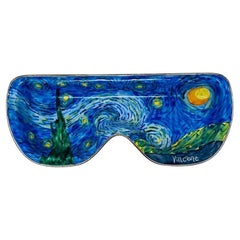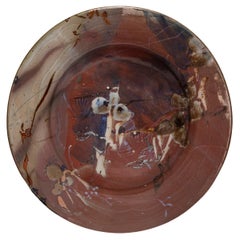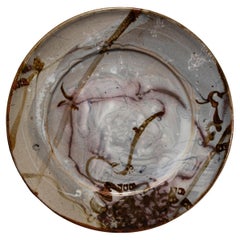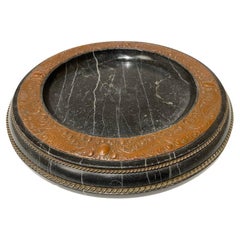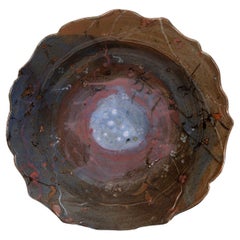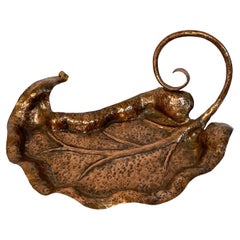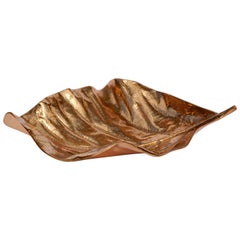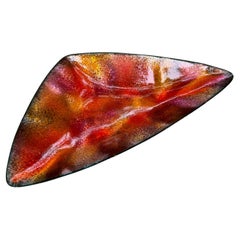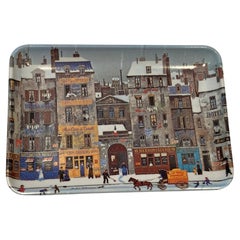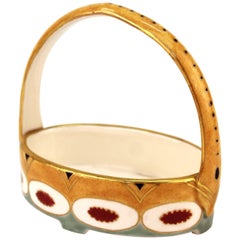Expressionist Decorative Dishes and Vide-Poche
to
2
6
1
1
6
2
2
3
3
1,229
321
264
226
89
58
46
37
35
30
29
26
22
16
7
7
7
4
5
3
2
2
1
8
4
4
4
3
1
Height
to
Width
to
8
7
7
3
1
1
Style: Expressionist
Kelvin Chen Vincent Van Gogh Starry Night Enameled Eyeglass Holder Tray
Located in San Diego, CA
Beautiful trinket dish or eyeglass or sunglasses tray. This piece by Kelvin Chen goes hand in hand with his whimsical designs that juxtapose iconic art leg...
Category
Early 2000s American Expressionist Decorative Dishes and Vide-Poche
Materials
Metal, Enamel
$96 Sale Price
20% Off
John Glick Plum Street Pottery Ceramic Charger Monumental
By John Glick
Located in Bloomfield Hills, MI
The ceramic charger is an example of the kind of work by which John Glick became so famous. He was seduced by the effects of the reduction kiln, which decreased the levels of oxygen during firing, inducing the flame to pull oxygen out of the clay and glazes changing the colors of the glazes depending on their iron and copper content. In this way he achieved the rich gradients of ochre and umber and variations in stippling and opacity. It is signed by the artist and stamped with Plum Street Pottery on the verso.
John was an American Abstract Expressionist ceramicist born in Detroit, MI. Though open to artistic experimentation, Glick was most influenced by the styles and aesthetics of Asian pottery—an inspiration that shows in his use of decorative patterns and glaze choices. He has said that he is attracted to simplicity, as well as complexity: my work continually reflects my re-examination that these two poles can coexist… or not, in a given series. Glick also took influences from master potters of Japan, notably Shoji Hamada and Kanjrio Kawai, blending their gestural embellishments of simple forms with attitudes of Abstract Expressionism. He was particularly drown to the work of Helen Frankenthaler whose soak-stain style resonated with Glick’s multi-layered glaze surfaces, which juxtaposed veils of atmospheric color with gestural marks and pattern. He spent countless hours developing and making his own tools in order to achieve previously unseen results in his work with clay and glaze.
Glick’s “Plum Tree Pottery” (now a designated historic landmark in Farmington Hills, Michigan) studio opened around 1965 and closed in the summer of 2016. It was a private studio space for John and a number of his students and assistants. He believed his shapes evolved guided by forces apparently outside his control. This was instinctual, intellectual and due to his openness to change, fusing into what he thought was the most positive force behind a potter’s approach: evolution and growth. Some have called it inspiration.
John was not only a major figure in the Detroit creative community, but in the ceramics world at large. According to Shelley Selim in her book on John, “John Glick: A Legacy in Clay” John remains: “one of the most recognizable names in the field of studio pottery – known for lecturing, publishing, and offering workshops widely – and his work has been featured in well over a hundred local, national and international exhibitions since he was a college student in the late 1950s.” Along with this John has mentored over thirty studio apprentices over five and a half decades, received numerous grants and awards for his work, and has been prolific, with an estimated 300,000 ceramic wares throughout the world.
He received his Masters from Cranbrook Academy of Art in Bloomfield Hills, Michigan, working with Maija Grotell, a legendary and influential teacher. Grotell was noted for her deep interest in the human connection to nature’s rhythms and patters. These ideas often grounded her dialog with her students including Glick, affecting, a profund and lasting influence on his future work. This famous Art Academy was designed by architect and faculty member, Eliel Saarinen who collaborated with Charles and Ray Eames on chair and furniture design. Numerous creative artists who are alumni of Cranbrook include: Harry Bertoia, Florence Knoll, Jack Lenor Larsen, Donald Lipski, Duane Hanson, Nick Cave, Hani Rashid, George Nelson, Urban Jupena (Nationally recognized fiber artist), Artis Lane (the first African-American artist to have her sculpture, "Sojourner Truth," commissioned for the Emancipation Hall in the Capital Visitor Center in Washington DC), Cory Puhlman (televised Pastry Chef extraordinaire), Thom O’Connor (Lithographs), Paul Evans (Brutalist-inspired sculpted metal furnishings), Eugene Caples (small bronze images/abstract), Morris Brose (Bronze Sculptures), Herb Babcock (blown glass), Larry Butcher (mixed media) and Lauren Anais Hussey...
Category
1990s American Expressionist Decorative Dishes and Vide-Poche
Materials
Ceramic
John Glick Plum Street Pottery Ceramic Charger Monumental
By John Glick
Located in Bloomfield Hills, MI
The ceramic charger is an example of the kind of work by which John Glick became so famous. He was seduced by the effects of the reduction kiln, which decreased the levels of oxygen during firing, inducing the flame to pull oxygen out of the clay and glazes changing the colors of the glazes depending on their iron and copper content. In this way he achieved the rich gradients of ochre and umber and variations in stippling and opacity. It is signed by the artist and stamped with Plum Street Pottery #129 on the verso.
John was an American Abstract Expressionist ceramicist born in Detroit, MI. Though open to artistic experimentation, Glick was most influenced by the styles and aesthetics of Asian pottery—an inspiration that shows in his use of decorative patterns and glaze choices. He has said that he is attracted to simplicity, as well as complexity: my work continually reflects my re-examination that these two poles can coexist… or not, in a given series. Glick also took influences from master potters of Japan, notably Shoji Hamada and Kanjrio Kawai, blending their gestural embellishments of simple forms with attitudes of Abstract Expressionism. He was particularly drown to the work of Helen Frankenthaler whose soak-stain style resonated with Glick’s multi-layered glaze surfaces, which juxtaposed veils of atmospheric color with gestural marks and pattern. He spent countless hours developing and making his own tools in order to achieve previously unseen results in his work with clay and glaze.
Glick’s “Plum Tree Pottery” (now a designated historic landmark in Farmington Hills, Michigan) studio opened around 1965 and closed in the summer of 2016. It was a private studio space for John and a number of his students and assistants. He believed his shapes evolved guided by forces apparently outside his control. This was instinctual, intellectual and due to his openness to change, fusing into what he thought was the most positive force behind a potter’s approach: evolution and growth. Some have called it inspiration.
John was not only a major figure in the Detroit creative community, but in the ceramics world at large. According to Shelley Selim in her book on John, “John Glick: A Legacy in Clay” John remains: “one of the most recognizable names in the field of studio pottery – known for lecturing, publishing, and offering workshops widely – and his work has been featured in well over a hundred local, national and international exhibitions since he was a college student in the late 1950s.” Along with this John has mentored over thirty studio apprentices over five and a half decades, received numerous grants and awards for his work, and has been prolific, with an estimated 300,000 ceramic wares throughout the world.
He received his Masters from Cranbrook Academy of Art in Bloomfield Hills, Michigan, working with Maija Grotell, a legendary and influential teacher. Grotell was noted for her deep interest in the human connection to nature’s rhythms and patters. These ideas often grounded her dialog with her students including Glick, affecting, a profund and lasting influence on his future work. This famous Art Academy was designed by architect and faculty member, Eliel Saarinen who collaborated with Charles and Ray Eames on chair and furniture design. Numerous creative artists who are alumni of Cranbrook include: Harry Bertoia, Florence Knoll, Jack Lenor Larsen, Donald Lipski, Duane Hanson, Nick Cave, Hani Rashid, George Nelson, Urban Jupena (Nationally recognized fiber artist), Artis Lane (the first African-American artist to have her sculpture, "Sojourner Truth," commissioned for the Emancipation Hall in the Capital Visitor Center in Washington DC), Cory Puhlman (televised Pastry Chef extraordinaire), Thom O’Connor (Lithographs), Paul Evans (Brutalist-inspired sculpted metal furnishings), Eugene Caples (small bronze images/abstract), Morris Brose (Bronze Sculptures), Herb Babcock (blown glass), Larry Butcher (mixed media) and Lauren Anais Hussey...
Category
1990s American Expressionist Decorative Dishes and Vide-Poche
Materials
Ceramic
Vienna Secessionist Marble, Copper and Brass Platter Tray
Located in Stamford, CT
Austrian Belgian black marble dish with a wonderful copper repousse band with decoration typical of the Vienna Secession, that evokes the background ...
Category
Early 20th Century Austrian Expressionist Decorative Dishes and Vide-Poche
Materials
Belgian Black Marble, Brass, Copper
John Glick Plum Street Pottery Signed Monumental Ceramic Charger
By John Glick
Located in Bloomfield Hills, MI
The ceramic charger with scalloped edge is an example of the kind of work by which John Glick became so famous. He was seduced by the effects of the reduction kiln, which decreased the levels of oxygen during firing, inducing the flame to pull oxygen out of the clay and glazes changing the colors of the glazes depending on their iron and copper content. In this way he achieved the rich gradients of ochre and umber and variations in stippling and opacity. It is signed on verso.
John was an American Abstract Expressionist ceramicist born in Detroit, MI. Though open to artistic experimentation, Glick was most influenced by the styles and aesthetics of Asian pottery—an inspiration that shows in his use of decorative patterns and glaze choices. He has said that he is attracted to simplicity, as well as complexity: my work continually reflects my re-examination that these two poles can coexist… or not, in a given series. Glick also took influences from master potters of Japan, notably Shoji Hamada and Kanjrio Kawai, blending their gestural embellishments of simple forms with attitudes of Abstract Expressionism. He was particularly drown to the work of Helen Frankenthaler whose soak-stain style resonated with Glick’s multi-layered glaze surfaces, which juxtaposed veils of atmospheric color with gestural marks and pattern. He spent countless hours developing and making his own tools in order to achieve previously unseen results in his work with clay and glaze.
Glick’s “Plum Tree Pottery” (now a designated historic landmark in Farmington Hills, Michigan) studio opened around 1965 and closed in the summer of 2016. It was a private studio space for John and a number of his students and assistants. He believed his shapes evolved guided by forces apparently outside his control. This was instinctual, intellectual and due to his openness to change, fusing into what he thought was the most positive force behind a potter’s approach: evolution and growth. Some have called it inspiration.
John was not only a major figure in the Detroit creative community, but in the ceramics world at large. According to Shelley Selim in her book on John, “John Glick: A Legacy in Clay” John remains: “one of the most recognizable names in the field of studio pottery – known for lecturing, publishing, and offering workshops widely – and his work has been featured in well over a hundred local, national and international exhibitions since he was a college student in the late 1950s.” Along with this John has mentored over thirty studio apprentices over five and a half decades, received numerous grants and awards for his work, and has been prolific, with an estimated 300,000 ceramic wares throughout the world.
He received his Masters from Cranbrook Academy of Art in Bloomfield Hills, Michigan, working with Maija Grotell, a legendary and influential teacher. Grotell was noted for her deep interest in the human connection to nature’s rhythms and patters. These ideas often grounded her dialog with her students including Glick, affecting, a profund and lasting influence on his future work. This famous Art Academy was designed by architect and faculty member, Eliel Saarinen who collaborated with Charles and Ray Eames on chair and furniture design. Numerous creative artists who are alumni of Cranbrook include: Harry Bertoia, Florence Knoll, Jack Lenor Larsen, Donald Lipski, Duane Hanson, Nick Cave, Hani Rashid, George Nelson, Urban Jupena (Nationally recognized fiber artist), Artis Lane (the first African-American artist to have her sculpture, "Sojourner Truth," commissioned for the Emancipation Hall in the Capital Visitor Center in Washington DC), Cory Puhlman (televised Pastry Chef extraordinaire), Thom O’Connor (Lithographs), Paul Evans (Brutalist-inspired sculpted metal furnishings), Eugene Caples (small bronze images/abstract), Morris Brose (Bronze Sculptures), Herb Babcock (blown glass), Larry Butcher (mixed media) and Lauren Anais Hussey...
Category
1990s American Expressionist Decorative Dishes and Vide-Poche
Materials
Ceramic
Austrian Secessionist Hand-Forged Copper Leaf Motif Bowl/Vide-Poche
Located in West Palm Beach, FL
Austrian Secessionist Hand-Forged Copper Leaf Motif Bowl/Vide-Poche
Austria, Circa 1920s
Of good size, this hand forged and engraved copper organic mod...
Category
20th Century Austrian Expressionist Decorative Dishes and Vide-Poche
Materials
Copper
$956 Sale Price
20% Off
Contemporary Italian Murano Glass Silver Blue Green Mosaic Centerpiece on Red
Located in New York, NY
Contemporary modern Murano Art glass Mosaic centrepiece: High quality of execution using the sophisticated technique of glass fusion with a see-through mosaic of murrine (each little...
Category
2010s Italian Expressionist Decorative Dishes and Vide-Poche
Materials
Silver Leaf
Pair of Wiener Werkstatte Brass Bowls by Dagobert Peche
Located in Atlanta, GA
A pair of brass bowl in stepped concentric form designed by Dagobert Peche (Austrian, 1887-1923) and for Wiener Werkstatte circa 1910s-1920s. In the iconic style of Vienna Secession,...
Category
Early 20th Century Austrian Expressionist Decorative Dishes and Vide-Poche
Materials
Brass
Related Items
Cast Bronze Decorative Leaf Vide Poche, Medium
Located in London, London
Elegant handmade cast bronze leaf in a polished bronze finish. They may be used as a bowl or just a beautiful decorative object.
Each of these splend...
Category
2010s Indian Expressionist Decorative Dishes and Vide-Poche
Materials
Bronze
Hand Crafted Triangle Shaped Enameled Copper Tray / Bowl, 20th Century
Located in San Juan Capistrano, CA
Hand Crafted Triangle Shaped Enameled Copper Tray / Bowl, 20th Century.
Category
20th Century Unknown Expressionist Decorative Dishes and Vide-Poche
Materials
Copper, Enamel
$236 Sale Price
20% Off
H 0.88 in W 8 in D 4 in
Hand-Cast Polished Bronze Indian Bowl, Vide-Poche
Located in London, London
Charming and elegant bronze Indian decorative bowl, vide-poche.
The piece is entirely handcrafted with great skills and talent. Cast using very traditional techniques, the bowl is p...
Category
2010s Indian Expressionist Decorative Dishes and Vide-Poche
Materials
Bronze
Vintage Enameled Copper Vide-Poche / Decorative Bowl Ascribable to Paolo De Poli
Located in Bresso, Lombardy
Made in Italy, 1960s.
This catchall is highly ascribable to Paolo de Poli and its shape seems to recall Gio Ponti's design.
It is made in thick enameled copper-
This vide-poche is ...
Category
1960s Italian Vintage Expressionist Decorative Dishes and Vide-Poche
Materials
Copper
$443 Sale Price
58% Off
H 2.17 in W 11.03 in D 6.7 in
Monumental Mid-20th Century American Studio Pottery Bowl
Located in Chicago, IL
A monumental-scale mid-20th century American studio hand-thrown glazed ceramic bowl with fantastic texture and earthy neutral glaze colors. Signed illegibly on the bottom.
Category
1970s American Vintage Expressionist Decorative Dishes and Vide-Poche
Materials
Ceramic
Verdigris Bronze Decorative Bowl with Legs, Vide-Poche
Located in London, London
Charming and unusual handmade polished cast bronze bowl.
Each of these original and elegant bowl is handmade individually. Cast using very traditional te...
Category
2010s Indian Expressionist Decorative Dishes and Vide-Poche
Materials
Bronze
Signed Vintage Pottery
Located in Seattle, WA
Signed vintage pottery. Grey blue abstract design on a bowl with the signature on the bottom.
Dimensions Diameter 12 ; 4 1/4 H.
Category
1970s Vintage Expressionist Decorative Dishes and Vide-Poche
Materials
Ceramic
Decorative Handmade Cast Brass Leaf Vide Poche, Large
Located in London, London
Each of these splendid brass leaves is handmade individually with incredible detail. Cast using very traditional techniques, they are polished capturing the raw finish of this noble ...
Category
2010s Indian Expressionist Decorative Dishes and Vide-Poche
Materials
Brass
Marble Tray Marquina Color with Leather Straps, Large
Located in Alcoy, Alicante
Marble trays with leather straps and brass bottom reinforcement. Leather tips on the legs to avoid scratching surfaces.
Marble is a non-foliated m...
Category
21st Century and Contemporary Spanish Expressionist Decorative Dishes and Vide-Poche
Materials
Marble
Carl Auböck Model #3431 'Knopferl' Brass Tray
Located in Glendale, CA
Carl Auböck model #3431 'Knopferl' brass tray. Designed in the 1950s, this incredibly refined and sculptural Viennese tray is executed in patinated and p...
Category
21st Century and Contemporary Austrian Expressionist Decorative Dishes and Vide-Poche
Materials
Brass
Rattan and Brass Italian Centerpiece Tray Basket, 1970s
Located in Barcelona, ES
Mid-Century Modern brass and rattan round tray basket or centerpiece.
It has a brass trim covering the top and brass handles at both sides.
Handcraft...
Category
20th Century Italian Expressionist Decorative Dishes and Vide-Poche
Materials
Brass
$1,041 Sale Price
20% Off
H 3.94 in W 13 in D 11.82 in
Marble Tray, Bidasar Tone with Leather Straps, Large
Located in Alcoy, Alicante
Bidasar Marble trays with leather straps and brass bottom reinforcement. Bidasar Marble Tray with an unfinished texture. Rain forest Indian marble, also known as Bidasar, is the fine...
Category
21st Century and Contemporary Spanish Expressionist Decorative Dishes and Vide-Poche
Materials
Marble
Previously Available Items
Michel Delacroix " Aux Caves du Temple" Melamine Rectangular Mini Tray 1979
By Michel Delacroix
Located in Moreno Valley, CA
Michel Delacroix " Aux Caves du Temple" Rectangular Small Tray circa 1979.
Vintage Michel Delacroix Paris Life Melamine Mini tray, Made in Italy
Michel Delacroix" Aux Caves du Temple...
Category
20th Century Italian Expressionist Decorative Dishes and Vide-Poche
Materials
Plastic
H 0.5 in W 6 in D 4.25 in
Wahliss Viennese Secessionist Austrian Porcelain Basket Dish
Located in Astoria, NY
Wahliss Viennese Secession porcelain basket-form dish with gilt accents, designed by architect Karl Klaus in Vienna. Mark underneath. Minor wear to the glaze.
Category
Early 20th Century Austrian Expressionist Decorative Dishes and Vide-Poche
Materials
Porcelain
Vienna Secessionist Opalescent Green Glass Bowl
Located in Astoria, NY
Vienna secessionist bowl in opalescent green glass, with thick heavily ribbed sides, the interior with several trapped bubbles. Small crescent nick...
Category
Early 20th Century Austrian Expressionist Decorative Dishes and Vide-Poche
Materials
Glass
Vintage Midcentury Expressionist Pottery Tray
Located in Wilton, CT
Expressionist pottery tray with slashes of clay and glaze in sharp contrast, circa mid-20th century. In the manner of Peter Voulkos. 10 3/4" long, 8 1/4" ...
Category
1950s American Vintage Expressionist Decorative Dishes and Vide-Poche
Materials
Pottery
Expressionist decorative dishes and vide-poche for sale on 1stDibs.
Find a broad range of unique Expressionist decorative dishes and vide-poche for sale on 1stDibs. Many of these items were first offered in the 21st Century and Contemporary, but contemporary artisans have continued to produce works inspired by this style. If you’re looking to add vintage decorative dishes and vide-poche created in this style to your space, the works available on 1stDibs include decorative objects, serveware, ceramics, silver and glass and other home furnishings, frequently crafted with metal, ceramic and other materials. If you’re shopping for used Expressionist decorative dishes and vide-poche made in a specific country, there are Europe, North America, and United States pieces for sale on 1stDibs. While there are many designers and brands associated with original decorative dishes and vide-poche, popular names associated with this style include John Glick, Dagobert Peche, and Wiener Werkstätte. It’s true that these talented designers have at times inspired knockoffs, but our experienced specialists have partnered with only top vetted sellers to offer authentic pieces that come with a buyer protection guarantee. Prices for decorative dishes and vide-poche differ depending upon multiple factors, including designer, materials, construction methods, condition and provenance. On 1stDibs, the price for these items starts at $120 and tops out at $4,200 while the average work can sell for $2,940.
Recently Viewed
View AllMore Ways To Browse
Black Bachelors Chest
Black Gustavian Chest
Black Lacquer Bedroom Sets
Bleached Burl
Blind Door Cabinet
Blue Swedish Chest
Brise Fan
Burl Wood China Cabinet
Bust Planter
Cabinet Fabric Doors
Cabinet In Cedar
California Native American
Carson Pirie Scott
Carved Oak Bureau
Ceramic Swallows
Cherry Amber
Chinese Kitchen Chest
Chinese Lacquer And Stone Cabinet
